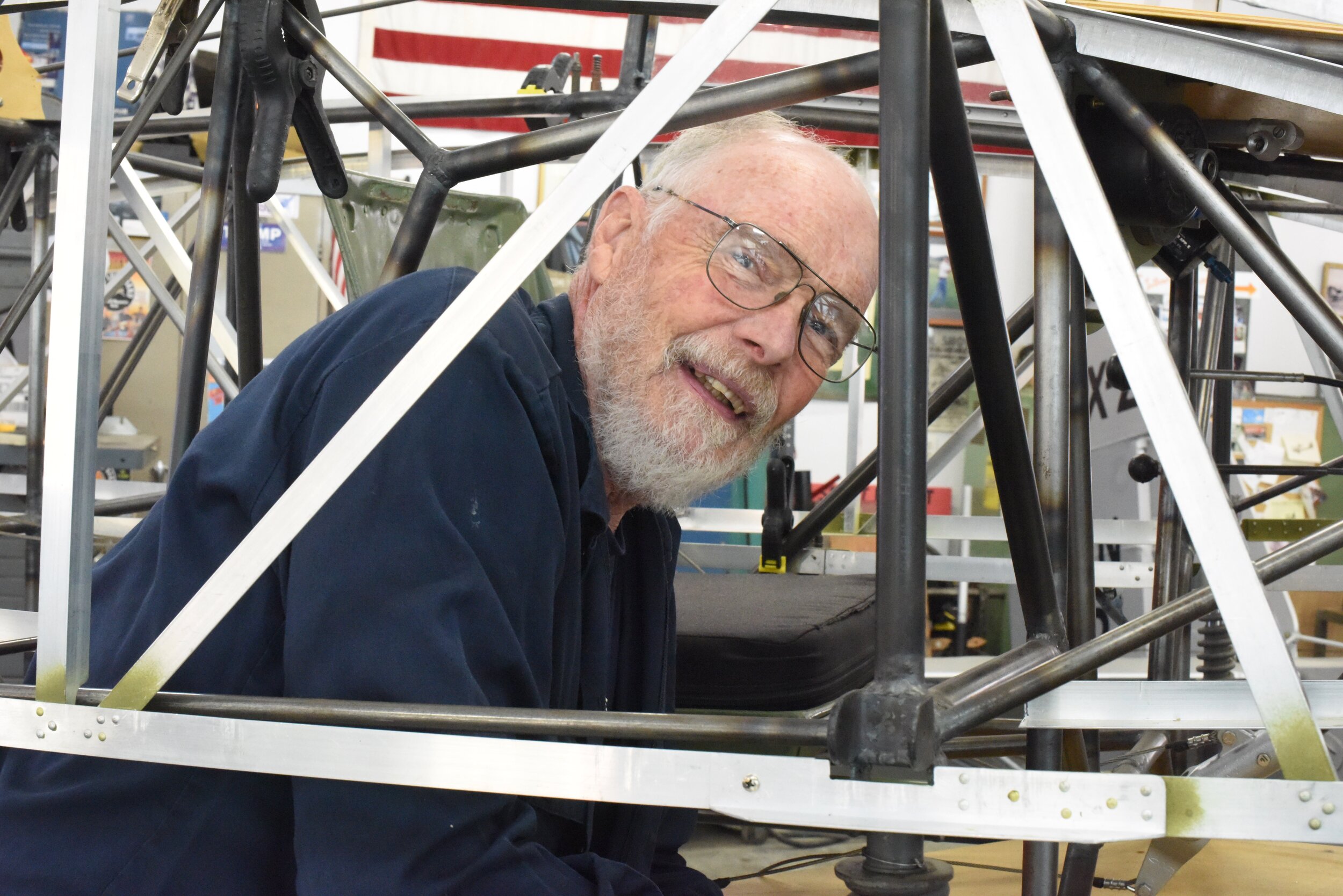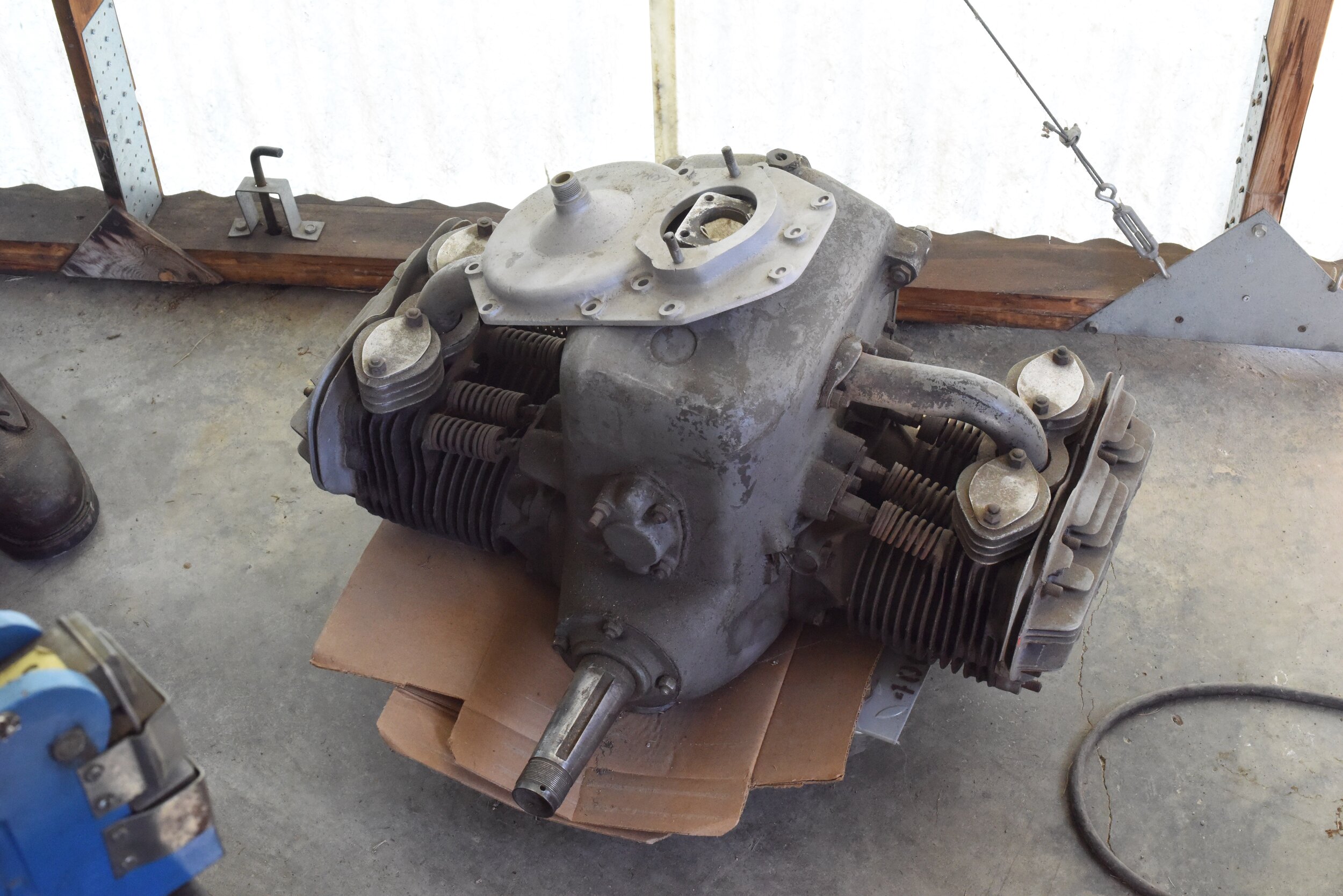Ken Cassens builds an Arup
Master aircraft mechanic Ken Cassens leans against the fuselage of the Arup flying wing he is building at the Old Rhinebeck Aerodrome.
Words-photos: Mike Blanchard
Ken Cassens is the retired head of aircraft maintenance at the Old Rhinebeck Aerodrome. Over the years he has had a hand in re-creating several historic aircraft.
During a recent visit we got to see what he is currently working on. In the main shop next to the Aerodrome’s replica Spirit of St. Louis sat the bare steel tube frame for a small aircraft. On the bench were the beginnings of a wing with the spars laid out.
Cassens is building another airplane, the Arup S-2. The Arup was the brainchild of Dr. Cloyd Snyder, a podiatrist and flying enthusiast who hit upon the idea when he flipped a heel insert for a shoe toward his bench and the thing flew.
Inspired by this, he made some models and built a glider to test his concept. He hired an established engineer to draw up the craft and put together Arup Inc. to build and sell the craft. In 1930, he applied for a patent, which was granted in 1932.
There were four variations made, S-1 through S-4. The Arup had a surprising turn of speed for its period, and from a small engine at that. The Arup’s other asset is that it has a very slow stall speed. Something like 35 mph with a landing speed of 24 mph.
Despite the fact that the aircraft flew well and was very efficient, the company could not generate much interest in a new concept.
Some of the examples that were made ended up as flying billboards. Because there was so much wing, you could write advertising slogans on it.
Cassens is working from a very basic set of plans. But he has a great deal of experience recreating vintage aircraft. You can see measurements in pencil around the rear of the wing.
Cassens was happy to talk about his new project. “I was the head guy, but I retired. Mike Mondello is the head guy now,” said Cassens. “I’m sorta just helping him out, doing stuff I want to. But I’m here just about every day. The Arup is my project, but The Old Rhinebeck Aerodrome will end up with it. … I’m using up my stash of parts. … I had this pipe dream. I’ve always wanted to build one.”
So Cassens talked with the Aerodrome board and asked if he could build it in their shop, and they gave him the go-ahead.
“It’s got real good performance. I wouldn’t be building it if it didn’t,” said Cassens. “Unfortunately, there were no plans for it. All we got is a 3-D drawing, and it’s pretty accurate, and this picture here of it under construction. A guy named Allison did that. Basically he was able to scale that drawing from photographs. He knew what the dimensions of the engine were, so he took everything based on the engine dimensions and scaled it to the airframe.”
Rust. The drawing looks like something you would see in Popular Mechanics.
“Well if you go on YouTube there’s actually pictures of it flying.”
Cassens with an RC model of the Arup S-2.
Rust. Where were they built?
“In South Bend Ind. It was a concept airplane. The designer was actually a foot doctor. What gave him the inspiration for this; he had a felt heel insert for a shoe. He gave it a toss to throw it on his desk and the thing flew; it sailed.
“He was interested in aviation. He built models and came up with this. He got an aeronautical engineer named Raul Hoffman to help him. The idea was: He envisioned these with hundred-foot wing spans and all the passengers would be in the wing. Seated in the wing with Plexiglas windows. It flew real well. The test pilot was Glen Doolittle, a distant cousin of Jimmy Doolittle.
“They flew it all over the place at different air shows. But they couldn’t get funding. It was 1933 and they just couldn’t get. … Here are some pictures of it. I was able to get this N number for it.
“I am planning on putting an 85-horse Continental on it. These A-40s were not too reliable. They’re a flathead. Every five hours you had to oil those external valves. That (A-40) actually started the whole four-cylinder opposed engine. Early Continental and then they went to the 50s and 65s and right on up, and then Lycoming followed on the same basic four-cylinder-opposed design.”
Continental A-40 engines like this one powered the original Arup aircraft but Cassens will be using a more modern Continental for reliability and more power.
Rust. How fast will it go?
“It was almost a hundred on 37 hp.”
Rust. You are going to have more horsepower.
“Yeah. The thing is, without any drawings I’m going to be pretty heavy, I think, compared to what they had.”
Rust. Did they make the main frame out of steel or wood?
"The frame was steel and the wing was all wood. In this photograph you can see all the white color was wood and then the steel fuselage. These had wood spars, built-up trusses. The third and fourth one they made metal tubing spars, which is what I’m going to do on this one. Still haven’t decided, but I think I’m going to do the rest of the wing in wood.”
Rust. Does the wing fold up?
“No, no; it’s all one piece. It’s only 23-foot span tip to tip.” Ken points to flaps at the trailing edge of the wing. “Initially these were the ailerons. But on the test flight they didn’t have enough roll rate, so what they did was they locked these off and made them adjustable for trimming and these (the rounded flaps off the end of the wing) were the ailerons.
“The other unusual thing is you enter the airplane from underneath. There’s a bi-fold door that forms the bottom of the wing and the side of the fuselage. And that folds up inside here and you just walk up into this section here. You sort of turn and step here. You inch your way into it.
You got to get a little gymnastic to get into it. I’ve been in it a couple times. In the side of the fuselage on each side there’s a window and in the bottom of the wing right up here there’s a window. Because it sits on the ground like this and it comes in like that, too. High angle of attack. It lands at 23 mph.”
Rust. What’s the takeoff speed?
“It’s probably about 25, something like that. There is 211 square feet of wing.”
Rust. Is it stable?
“It appears to be. A friend of mine built a 45-inch electric RC model of it. it flies great. If you watch the YouTube videos on it, the old newsreel footage, it seems to fly pretty good. It gets off pretty fast.”
Rust. How long to completion?
“Well that’s a good question. It depends on how much time I can put into it. I get caught up in all these little side jobs.”





